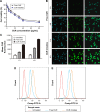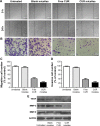Delivery of curcumin by directed self-assembled micelles enhances therapeutic treatment of non-small-cell lung cancer
- PMID: 28435247
- PMCID: PMC5388225
- DOI: 10.2147/IJN.S128921
Delivery of curcumin by directed self-assembled micelles enhances therapeutic treatment of non-small-cell lung cancer
Erratum in
-
Erratum: Delivery of curcumin by directed self-assembled micelles enhances therapeutic treatment of non-small-cell lung cancer [Corrigendum].Int J Nanomedicine. 2017 Nov 22;12:8375-8376. doi: 10.2147/IJN.S141401. eCollection 2017. Int J Nanomedicine. 2017. PMID: 29200849 Free PMC article.
Abstract
Background: It has been widely reported that curcumin (CUR) exhibits anticancer activity and triggers the apoptosis of human A549 non-small-cell lung cancer (NSCLC) cells. However, its application is limited owing to its poor solubility and bioavailability. Therefore, there is an urgent need to develop a new CUR formulation with higher water solubility and better biocompatibility for clinical application in the future.
Materials and methods: In this study, CUR-loaded methoxy polyethylene glycol-polylactide (CUR/mPEG-PLA) polymeric micelles were prepared by a thin-film hydration method. Their characteristics and antitumor effects were evaluated subsequently.
Results: The average size of CUR/mPEG-PLA micelles was 34.9±2.1 nm with its polydispersity index (PDI) in the range of 0.067-0.168. The encapsulation efficiency and drug loading were 90.2%±0.78% and 9.1%±0.07%, respectively. CUR was constantly released from the CUR/mPEG-PLA micelles, and its cellular uptake in A549 cells was significantly increased. It was also found that CUR/mPEG-PLA micelles inhibited A549 cell proliferation, increased the cell cytotoxicity, induced G2/M stage arrest and promoted cell apoptosis. Moreover, the CUR/mPEG-PLA micelles suppressed the migration and invasion of A549 cells more obviously than free CUR. Additionally, CUR/mPEG-PLA micelles inhibited human umbilical vein endothelial cells migration, invasion and corresponding tube formation, implying the antiangiogenesis ability. Its enhanced antitumor mechanism may be related to the reduced expression of vascular endothelial growth factor, matrix metalloproteinase (MMP)-2, MMP-9 and Bcl-2 as well as the increased expression of Bax.
Conclusion: The mPEG-PLA copolymer micelles can serve as an efficient carrier for CUR. The CUR/mPEG-PLA micelles have promising clinical potential in treating NSCLC.
Keywords: A549 cells; HUVECs; angiogenesis; curcumin; mPEG–PLA; polymeric micelles.
Conflict of interest statement
Disclosure The authors report no conflicts of interest in this work.
Figures







Similar articles
-
Curcumin Delivery by Poly(Lactide)-Based Co-Polymeric Micelles: An In Vitro Anticancer Study.Pharm Res. 2016 Apr;33(4):826-41. doi: 10.1007/s11095-015-1830-z. Epub 2015 Nov 23. Pharm Res. 2016. PMID: 26597940
-
Biodegradable micelles enhance the antiglioma activity of curcumin in vitro and in vivo.Int J Nanomedicine. 2016 Jun 9;11:2721-36. doi: 10.2147/IJN.S102450. eCollection 2016. Int J Nanomedicine. 2016. PMID: 27354801 Free PMC article.
-
Pharmacokinetics and in vivo delivery of curcumin by copolymeric mPEG-PCL micelles.Eur J Pharm Biopharm. 2017 Jul;116:17-30. doi: 10.1016/j.ejpb.2016.10.003. Epub 2016 Oct 15. Eur J Pharm Biopharm. 2017. PMID: 27756682
-
Progress in nanotechnology-based drug carrier in designing of curcumin nanomedicines for cancer therapy: current state-of-the-art.J Drug Target. 2016;24(4):273-93. doi: 10.3109/1061186X.2015.1055570. Epub 2015 Jun 11. J Drug Target. 2016. PMID: 26066739 Review.
-
Liposomal curcumin and its application in cancer.Int J Nanomedicine. 2017 Aug 21;12:6027-6044. doi: 10.2147/IJN.S132434. eCollection 2017. Int J Nanomedicine. 2017. PMID: 28860764 Free PMC article. Review.
Cited by
-
Nanoscale Formulations: Incorporating Curcumin into Combination Strategies for the Treatment of Lung Cancer.Drug Des Devel Ther. 2021 Jun 21;15:2695-2709. doi: 10.2147/DDDT.S311107. eCollection 2021. Drug Des Devel Ther. 2021. PMID: 34188448 Free PMC article. Review.
-
Novel Findings about Double-Loaded Curcumin-in-HPβcyclodextrin-in Liposomes: Effects on the Lipid Bilayer and Drug Release.Pharmaceutics. 2018 Dec 3;10(4):256. doi: 10.3390/pharmaceutics10040256. Pharmaceutics. 2018. PMID: 30513858 Free PMC article.
-
Curcumin Induces Apoptosis of Chemoresistant Lung Cancer Cells via ROS-Regulated p38 MAPK Phosphorylation.Int J Mol Sci. 2022 Jul 26;23(15):8248. doi: 10.3390/ijms23158248. Int J Mol Sci. 2022. PMID: 35897820 Free PMC article.
-
Porous Polymeric Microspheres With Controllable Pore Diameters for Tissue Engineered Lung Tumor Model Development.Front Bioeng Biotechnol. 2020 Jul 10;8:799. doi: 10.3389/fbioe.2020.00799. eCollection 2020. Front Bioeng Biotechnol. 2020. PMID: 32754585 Free PMC article.
-
Smart Nanoformulation Based on Stimuli-Responsive Nanogels and Curcumin: Promising Therapy against Colon Cancer.ACS Omega. 2020 Apr 15;5(16):9171-9184. doi: 10.1021/acsomega.9b04390. eCollection 2020 Apr 28. ACS Omega. 2020. PMID: 32363269 Free PMC article.
References
-
- Torre LA, Bray F, Siegel RL, Ferlay J, Lortet-Tieulent J, Jemal A. Global cancer statistics, 2012. CA Cancer J Clin. 2015;65(2):87–108. - PubMed
-
- Hirsch FR, Suda K, Wiens J, Bunn PA., Jr New and emerging targeted treatments in advanced non-small-cell lung cancer. Lancet. 2016;388(10048):1012–1024. - PubMed
-
- Pilkington G, Boland A, Brown T, Oyee J, Bagust A, Dickson R. A systematic review of the clinical effectiveness of first-line chemotherapy for adult patients with locally advanced or metastatic non-small cell lung cancer. Thorax. 2015;70(4):359–367. - PubMed
-
- Duvoix A, Blasius R, Delhalle S, et al. Chemopreventive and therapeutic effects of curcumin. Cancer Lett. 2005;223(2):181–190. - PubMed
MeSH terms
Substances
LinkOut - more resources
Full Text Sources
Other Literature Sources
Medical
Research Materials
Miscellaneous

